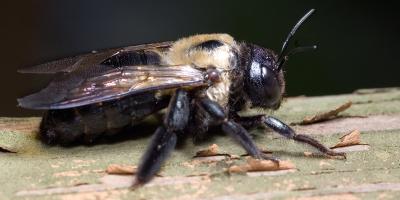The Sting Behind Summer’s Sweetest Months

Ahhh, August. In New England especially, the latter half of August represents a reprieve from the just-passed (or survived) warmest time of the year. Air conditioners can look forward to less exhausting work schedules, kids aren’t hiding in climate controlled video game dens, and the words “let’s get some fresh air” are actually a welcomed invitation. So you run outside to embrace the quintessence of summer, likely leaving a trail of bubbles via your feel-good wand of nostalgia, only to rile up a nest of the brightest bullies on the block: wasps and yellow jackets.
While you’re outside messing around, these stinging wasps are doing anything but. These territorial terrors don’t take kindly to threats posed against their nests, and will sting multiple times until the threat is gone. Seeing as wasps are roughly the size of a fingernail, humans impose a very major threat to the livelihood of a nest that has been the product of months of steadfast work.
The Best Defense Is A Good Offense
For most of the spring and summer, Yellow jackets aren’t so much aggressive as they are protective. The family of upwards of 1,000 wasps that they take up arms, or stingers for, was raised entirely from scratch just a few months ago. A young queen emerged from winter dormancy in the spring and found some real estate within yours, setting up shop for what grew to be hundreds of workers. In other words, Yellow jackets work very hard to build and maintain the nest, and the bigger the hive the longer it thrives.
This isn’t to say that the wasps in your yard have any Napoleonic intention of taking over your entire acreage. In fact, wasps won’t even return to a nest that was built the previous year. Though the nest population can grow into the thousands, Yellow jackets aren’t looking to expand their territory, just maintain it until the final fertile broods of the queen fly away to form colonies of their own. (The majority of the wasps are sterile.)
So, whereas these wasps’ best defense is a good offense, it would benefit you to take the flip side of such a stance and avoid the nests altogether. Unfortunately for most homeowners and their families, this only works until late summer. What exactly, then, causes the switch to flip from defense to aggression?
Sugar-Loving Socialites
The aforementioned hard work on the wasps’ behalf doesn’t come without a fruitful retirement. In the case of Yellow jackets, it’s literally a fruit-filled retirement. For months, the workers not only had to defend the nest, but also had to provide a constant nutrient-packed bill of fare for their metamorphosing sisters.
If you consider these wasps predators, you are correct, but not simply because of a swarm’s arsenal of stingers. They are actually a predatory species, preying on insects like caterpillars, flies, and crickets and scavenging protein from other dead insects and carrion. This is why you may run into them flying around your garbage or near your kitchen. The bits of dead bugs and decaying meats provide the essential nutrients for larvae to grow, and, like in any busy family household, the adult wasps hardly have any time to nurture themselves.
For months the only way to invoke an attack is by agitating the nest. Then, just when you’re stepping outside and taking in the most quintessential summer breeze, Yellow jackets are diving into your sugary beverage, taking their own sips and proclaiming “Ahh, sweet retirement!” With no obligation to defend and hunt for their now-gone fertile siblings, the only thing left for these wasps to do is drink and be merry until their inevitable winter deaths. As adults, the only things they want are sugary foods and beverages that offer a quick boost of energy.
Essentially, with nothing but (limited) time on their hands and no nest holding them back, the adults roam the yards of New England searching for the next quick sugar fix.
A Sugar Rush You Can Do Without
There’s nothing sweet about a wasp in your soda can, or a few of them catching on to the fact that you’re the holder of the ice cream cone. As territorial as they are over their nest, they will flock in similar numbers to a family picnic. While you may not see a single nest as a threat, that single nest could be the meeting place of thousands of wasps. Though stinging insect problems can be treated one nest at a time, for best results, we recommended that a season-long prevention plan is implemented.
JP Pest Services offers full prevention plans that will control the obvious locations on a structure where nests are typically found, as well as providing on-call service to handle any additional locations where property owners discover additional nests throughout the season.



